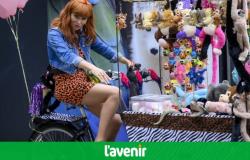
Those who love the writer’s wanderings know how Jean Rolin has no equal when it comes to describing these sides of the world that no one sees, whether they are very close to Paris, or at the top of the Kurdish mountains, these details sometimes tiny which nevertheless give meaning to the world and of which he speaks in beautiful crafted sentences.
There is no intrigue, no suspense. We find this very particular voice, this apparently simple but so elaborate writing, in The Butterflies of the penal colony.
The story begins with an aborted project. He had undertaken to walk along the French Riviera, between Hyères and Menton, in the footsteps of Katherine Mansfield, and incidentally of the filming in Porquerolles of Pierrot le fou, Godard’s masterpiece. But realizing that the region is haunted by too many literary figures, he changes plans, discovering a sequence from the film Butterfly adapted from the best-seller by Henri Charrière where Steve McQueen and Dustin Hoffman “are working to capture Morpho-style butterflies, before handing them over to a prison officer. ”
Jean Rolin: The Crossing of Bondoufle
“But the link, he writes, that this sequence showed between the penal colony, the quintessence of violence and vice, to speak in the language of the period, and the butterfly hunt, which the public represents rather as a leisure activity for good children or old crazy people , excited my curiosity to the point of inspiring me with an irrepressible desire to go and see. ”
Lepidopterists
The Morpho is the star of “lepidopterists”, the name given to butterfly hunters and collectors. Their Holy Grail is to possess Morphos, these very large butterflies with iridescent blue wings, a metallic blue. It is found in numbers in Guyana where in the past convicts scrounged up a few francs by capturing them in traps and made mosaics with their wings which they sold to travelers.
gullThe butterfly is the providence, in Guyana, of the liberated and the escaped.
Jean Rolin loves animals. After observing solitary dogs around the world (A dead dog after him2009) and birds (The Kurdish Wheatear, 2018), he therefore goes hunting for butterflies and the story of this passion, sometimes cruel (you have to suffocate the animal between your fingers).
The Kurdish Wheatear by Jean Rolin
He prepares his trip to Guyana by visiting the Juvisy fair, in Essonne, theArt Paris for butterfly lovers! And he read everything, soaking up as much of the exploits depicted by Eugène Le Moult in his book My butterfly hunts (1955) than the discovery that Nabokov was also another enthusiast of these insects who, in 1950, saw in a pine-covered moor in New York State named Karner, a specimen whose vulgar name would become Karner blue.
The Hmongs in Guyana
The whole pleasure of reading Jean Rolin is to let ourselves be guided by his observations which he manages to make fascinating for us. He thus discovered a boat wreck in Guyana calledEdith Cavell, the Anglo-Belgian heroine of 14-18. He finds traces of Wallace, the man who discovered the theory of evolution with Darwin but was then largely forgotten by the history of science.
With Jean Rolin, we travel by canoe into the jungle to discover the Morphoswe have lunch in bouis-bouis, we learn that we have to blow with a straw into the caterpillars to preserve them or we meet a Hmong population from Laos and deported to this jungle.
And always there is this strange link between the hell of the penal colony and the delicacy of the butterfly hunt. Often the “relegated” and “deported” suffered double punishment. Once free, they had to end their days in Guyana without being authorized to return to France.
Of course, it’s not just the Morpho which interests Jean Rolin but what he has to say about men. With this butterfly as a guide and with his humor and scholarly erudition, the writer gives us a bit of the history and poetry of the world.
⇒ The butterflies of the penal colony | Story | Jean Rolin | POL, 208 pp., €19, digital €14
EXTRACT
“In the increasing darkness, which made me half-blind, I could distinguish at some distance an island of vegetation, composed of mangrove trees and therefore generally green in color, dotted with white spots. […] and topped by what I first took to be a crown of red flowers before noticing that it was quivering, that it was undulating and understanding that it was a compact troop of scarlet ibises. ”





